Here we are at the Beijing snack street!!! Get ready foodies….
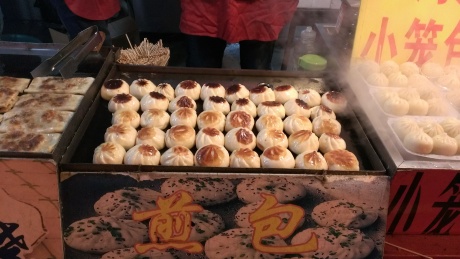
Baozi is a standard snack that you will find literally everywhere from restaurants to 7/11. I LOVE THEM ❤

super yummy nut cake things
Here I go…. http://youtu.be/DYbIV6gtcME
About 15 million people currently reside in China’s fourth largest city. Tianjin, which hosted the water events of the 2008 Olympics Games, encompasses rapid growth on a massive scale. This city is massive, and jam-packed with a similar style build that I saw previously in China. But this city is very different from Beijing and Shanghai because it is not an ‘international city’. Whereas the capital is home to many government consulates and foreign businesses, in Tianjin seeing a foreigner is a very rare sight. My time spent in Tianjin was extra special, because I got to spend time with Jakes chinese family.
When we arrived, we were picked up at the train station by our hosts and their family friends (who conveniently had a large minivan). We proceeded to get lunch! I was nervous because this would be the first time I got a full dose of eating a meal at a restaurant with China natives. Going to a restaurant in China is incredibly different than in the US. Main differences: 1. No services with a smile b/s 2. You pay before you eat 3. Lack of cleanliness/everybody just throws their trash on the ground (which means you are sitting in a room filled with food, trash and cig. butts). I was nervous at first, but once the food came I settled in. The families didn’t know a word of english, so Jake had to translate everything for me. All of the dishes ordered were really good (except the fish) and I was pressured into eating massive amounts of food by the families… which i’m pretty sure is a cultural courtesy in China. Afterwords I enjoyed a moment of zen when I was told that I had exceptional chopstick skills for an American 😀
Our next stop was the Tianjin cultural street!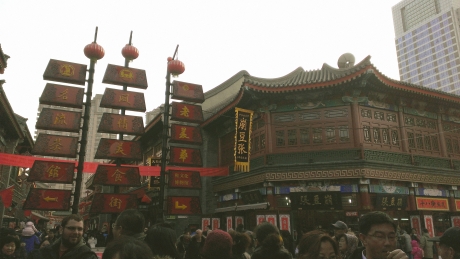 They told us to wear our bags on our front to prevent theft.
They told us to wear our bags on our front to prevent theft. We also ate these Tianjin special treats that were kinda like honey cake but with carmel. REALLY, REALLY YUMMY!
We also ate these Tianjin special treats that were kinda like honey cake but with carmel. REALLY, REALLY YUMMY!

 Another unique thing we saw was this guy blowing sculpture animals out of caramel, which I was told was a traditional/ lost art in the region…. you wouldn’t want to eat it though… because the guy had his dirty hands all over the recycled caramel. This girl thought it was pretty cool… I thought it was kinda gross.
Another unique thing we saw was this guy blowing sculpture animals out of caramel, which I was told was a traditional/ lost art in the region…. you wouldn’t want to eat it though… because the guy had his dirty hands all over the recycled caramel. This girl thought it was pretty cool… I thought it was kinda gross.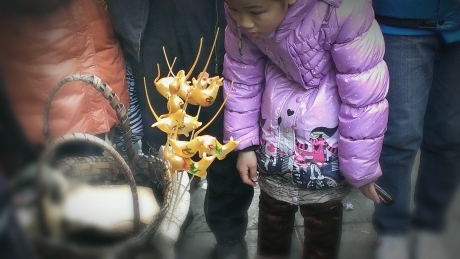 We went into a mall to take some pictures. Homeboy on the right was really prepared with a camera tripod and timer set on the camera (standard chinese tradition :P)
We went into a mall to take some pictures. Homeboy on the right was really prepared with a camera tripod and timer set on the camera (standard chinese tradition :P) They took us to see the newly constructed historical museums. This whole segment of town was built within just one year (5 massive buildings and a lake).
They took us to see the newly constructed historical museums. This whole segment of town was built within just one year (5 massive buildings and a lake). and we took more pictures infront of this crazy color-changing building.
and we took more pictures infront of this crazy color-changing building. Before going to dinner we saw this crazy wedding cake shop that had super-luxury cakes. China is filled with lots of luxury goods, so why not have super luxury wedding cakes? …amirite?
Before going to dinner we saw this crazy wedding cake shop that had super-luxury cakes. China is filled with lots of luxury goods, so why not have super luxury wedding cakes? …amirite?  Thats about 1/2 mil USD
Thats about 1/2 mil USD
 Eventually we went to dinner where we again consumed massive amounts of food and then headed back to the train station. From there I got my last glimpse of this amazing city. This is a view of their ‘little italy’, a section of town that was developed under imperial ruling of Italy.
Eventually we went to dinner where we again consumed massive amounts of food and then headed back to the train station. From there I got my last glimpse of this amazing city. This is a view of their ‘little italy’, a section of town that was developed under imperial ruling of Italy.  Tianjin is an amazing place to see. Its doesn’t quite fit into the same categories as Beijing or Shanghai because it not a touristy kind of place, but its packed full of huge city and industrial development. Also, I would advise against eating the fish… it kinda tastes like polluted water.
Tianjin is an amazing place to see. Its doesn’t quite fit into the same categories as Beijing or Shanghai because it not a touristy kind of place, but its packed full of huge city and industrial development. Also, I would advise against eating the fish… it kinda tastes like polluted water.
 The public transit system in Beijing is freaking amazing. Its new infrastructure puts everything i’ve ever seen to shame. Everything is new, clean, and had large open spaces. I mainly took the line 2 which seemed to lack the usual amount of crazy people that I am used to seeing on a train ride. A trip on the Beijing subway cots ¥2 (equal to $0.32 USD) which beats the hell out of Chicago’s $2.25.
The public transit system in Beijing is freaking amazing. Its new infrastructure puts everything i’ve ever seen to shame. Everything is new, clean, and had large open spaces. I mainly took the line 2 which seemed to lack the usual amount of crazy people that I am used to seeing on a train ride. A trip on the Beijing subway cots ¥2 (equal to $0.32 USD) which beats the hell out of Chicago’s $2.25.

 Just so that you know, its kinda weird being a white dude on a train in China. The effects of being a minority are in full force. One must be prepared for random people to take pictures of you at point blank range, and little kids will be laughing and staring at the mei guo ren (america people). Also, its a fun game to stare back at other people directly in the eyes. They will quickly look away as though they weren’t surprised by your appearance. I had many moments where chinese women were obviously very scared and quickly turn in the other direction to avoid walking near me. HAHAHAHHA….
Just so that you know, its kinda weird being a white dude on a train in China. The effects of being a minority are in full force. One must be prepared for random people to take pictures of you at point blank range, and little kids will be laughing and staring at the mei guo ren (america people). Also, its a fun game to stare back at other people directly in the eyes. They will quickly look away as though they weren’t surprised by your appearance. I had many moments where chinese women were obviously very scared and quickly turn in the other direction to avoid walking near me. HAHAHAHHA….

 Taking the bullet train was another trip and a half. Again the architectural infrastructure was super modern and all of the transit information was presenting in both Chinese and English. We travelled from Beijing to Tianjin, a trip that by car takes roughly two hours. On a bullet train going about 200km/h it took us just under 30 minutes.
Taking the bullet train was another trip and a half. Again the architectural infrastructure was super modern and all of the transit information was presenting in both Chinese and English. We travelled from Beijing to Tianjin, a trip that by car takes roughly two hours. On a bullet train going about 200km/h it took us just under 30 minutes.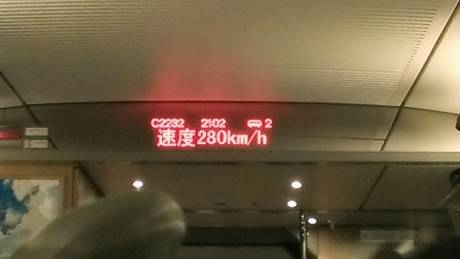

The picturesque Nanjing street in Shanghai is undoubtedly one of the coolest sights to see. The famous walking street is packed with people browsing the luxury goods stores, dinner & snacks, street vendors, bars and other special entertainment.
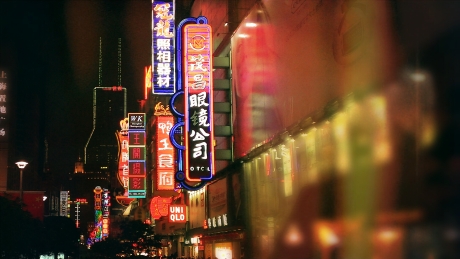

 It is the Times Square of Shanghai
It is the Times Square of Shanghai
Roughly 1k away from the bund is the yuyuan market which coincidentally has lots of people.


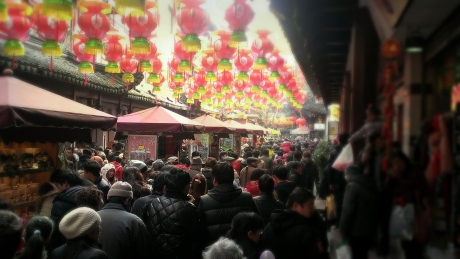
Among many of the shops, I was most interested with this medicine shop. It contained jars full of dried roots, herbs & spices, mushrooms, teas, and other assorted powders and weird icky looking stuff. Customers would consult the herbalists behind the counter to weigh out and sometimes grind up their medicine.




 Shanghai has a very unique set of architectural styles that define its history and cultural heritage. The Huangpu river splits the city into two sections. On one side sits a newly revitalized financial district and on the other, imperialist era European style buildings. During my visit in Shanghai I stayed on the bund which is surrounded by fantastic neoclassical and art deco architecture from the 20th century.
Shanghai has a very unique set of architectural styles that define its history and cultural heritage. The Huangpu river splits the city into two sections. On one side sits a newly revitalized financial district and on the other, imperialist era European style buildings. During my visit in Shanghai I stayed on the bund which is surrounded by fantastic neoclassical and art deco architecture from the 20th century.
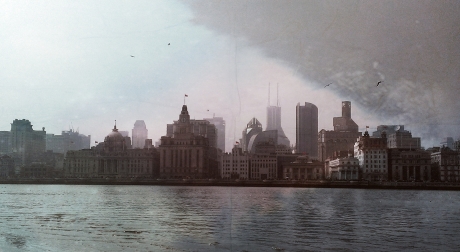
 Crossing over from one side to the other requires a ferry ride or you can take an exhilarating ride through a light tunnel.
Crossing over from one side to the other requires a ferry ride or you can take an exhilarating ride through a light tunnel. 


Nanluoguxiang (Nlgx), Beijing- The hutong style represents the architectural heritage of old Beijing. These neighborhoods are formed by siheyuan (house clusters) along narrow streets and alleys. As new Beijing overtakes the old, these style neighborhoods have been in decline from zoning demolition.

photo from google

A destroyed hutong neighborhood.
The Gulou district is home to the Nanluoguxiang Hutong, built in the Yuan dynasty (~1750). This street has brought a revitalizing urban twist to the hutong style. These old Beijing homes are rehabilitated and used as trendy clothing stores, bars, art galleries and micro-restaurants. 

storefronts at NLGX
The Nlgx design co. has iconized the characters used to mark areas of demolition by embracing a converse message. The DO NOT DESTROY markings has become a famed logo of opposition.
Most of the goods sold at the Nanlauguxiang street were original clothing apparel but I also found some fun counterfeit TOMS shoes. 